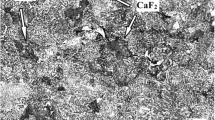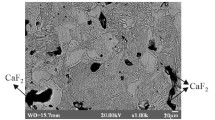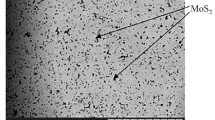The paper examines the effect of doping elements on the structurization and properties of a new antifriction composite produced from grinding waste of the R2AM9K5 high-speed tool steel and CaF2 solid lubricant. The composite is intended for operation at loads of 2.0–3.0 MPa and high rotation speeds (5,000–7,000 rpm) in contact joints of high-speed printing machines. The production process imparted a heterophase structure to the antifriction composite. The composite consists of a metal pearlite–carbide and carbonitride matrix and CaF2 solid lubricant particles being evenly distributed in it. Valuable Mo, Cr, W, V, N, and Co doping elements contained in the R2AM9K5 steel waste particles promote the formation of strengthening phases in the composite’s metal matrix. In combination with CaF2 solid lubricant, these strengthening phases impart high antifriction properties to the material under high-speed friction at speeds up to 7,000 rpm and loads of 2.0–3.0 MPa. Comparative tests of the new R2AM9K5 steel + (4.0−8.0)% CaF2 composite demonstrated significant advantages in the antifriction properties over cast brass, currently used for units of modern rotary printing machines and can perform effectively only under continuous liquid lubrication. The R2AM9K5 steel waste composite containing CaF2 solid lubricant permanently forms a protective antifriction film on the contact surfaces in the friction process, which was confirmed by electron microscopy studies. Under these friction conditions, the film is continuous, uniform, and smooth and is constantly restored on its worn areas, leading to self-lubrication. When the rotation speed increases up to 8,000 rpm, the composite antifriction properties decrease as the film on the contact surfaces becomes discontinuous. The research allowed operating limits to be determined for applying the new composite and proved the effectiveness of industrial grinding waste in developing high-quality structural materials through a reasoned choice of secondary raw materials, considering the nature of doping elements present in them.






Similar content being viewed by others
References
M. Vinoth and M.S. Aswathy, “Environmental effects of using copper mine tailings in various geotechnical applications,” Proc. Inst. Civ. Eng. Waste Resour. Manag., 175, Issue 3, 84–96 (2022), https://doi.org/10.1680/jwarm.21.00021.
Recycling Today (RT), Media Group Magazines and E-Newsletters, GIE Media, Inc., Ohio, USA (2022), https://www.recyclingtoday.com/page/about.
Advanced Recycling Conference, Conference Journal, November 14–15, 2022, Cologne, Germany (hybrid event), https://advanced-recycling.eu/, https://advanced-recycling.eu/wpcontent/uploads/2022/11/11_ARC-Journal-2022.pdf.
T. Roik, A. Rashedi, T. Khanam, A. Chaubey, Gurusami Balaganesan, and Sadaqat Ali, “Structure and properties of new antifriction composites based on tool steel grinding waste,” J. Sustainability, 13, Issue 16, No. 8823, 1–10 (2021), ISSN 2071-1050, https://doi.org/10.3390/su13168823, https://www.mdpi.com/2071-1050/13/16/8823/pdf.
T. Roik, O. Gavrysh, A. Rashedi, T. Khanam, Ali Raza, and B. Jeong, “New antifriction composites based on tool steel grinding waste for units of printing machines’ offset cylinders,” J. Sustainability, MDPI, Section “Sustainable Materials”, Special Issue “Materials for Sustainability”, 14, Issue 5 (2022), Website online, Sustainability, 14, 2799, 1–11 (2022), https://doi.org/10.3390/su14052799, https://doi.org/10.3390/su14052799, https://susy.mdpi.com/user/manuscripts/review_info/7f7f50a30d5ba6343ff4b07d8cae5382.
T.A. Roik and T.M. Omik, “Analyzing the properties of doped composites for friction parts in printing machines,” Tekhnol. Tekh. Druk., 57, No. 3, 20–30 (2017), https://doi.org/10.20535/2077-7264.3(57).2017.121528.
P.O. Kirichok, T.A. Roik, A.P. Gavrysh, A.V. Shevchuk, and Iu.Iu. Vitsiuk, Novel Composite Materials for Friction Parts of Printing Machines: Monograph [in Ukrainian], NTUU KPI, Kyiv (2015), p. 428, ISBN 978-066-622-692-4. https://scholar.google.com.ua/scholar?hl=uk&as_sdt=0,5&cluster=6673344392320605039; https://scholar.google.com/citations?view_op=view_citation&hl=ru&user=kYNz4dwAAAAJ&citation_for_view=kYNz4dwAAAAJ:yB1At4FlUx8C.
M.J. Neale (ed.), Tribology, Handbook, 2nd ed., Elsevier Ltd (1996), ISBN 978-0-7506-1198-5, https://doi.org/10.1016/B978-0-7506-1198-5.X5000-0.
T.A. Roik, O.A. Gavrysh, and Iu.Iu. Vitsiuk, “Tribotechnical properties of composite materials produced from ShKh15SG steel grinding waste,” Powder Metall. Met. Ceram., 58, No. 7−8, 439–445 (2019), https://doi.org/10.1007/s11106-019-00093w. http://link.springer.com/article/https://doi.org/10.1007/s11106-019-00093-w.
T.A. Roik, O.A. Gavrysh, and Iu.Iu. Vitsiuk, “Structural features and properties of antifriction composites produced from R6AM5 steel waste for printing equipment parts,” Powder Metall. Met. Ceram., 61, No. 5−6, 278−286 (2022), http://www.materials.kiev.ua/edition/1, ISSN 1068-1302. http://www.wkap.nl/journalhome.htm/1068-1302.
T.A. Roik, O.A. Gavrish, and Iu.Iu. Vitsiuk, “The phase composition and structure of the antifriction copper-based composite and their influence on tribological properties,” Powder Metall. Met. Ceram., 60, No. 3–4, 191–197 (2021), https://doi.org/10.1007/s11106-021-00227-z.
Krzysztof Jamroziak, Tetiana Roik, Oleg Gavrish, Iuliia Vitsiuk, Grzegorz Lesiuk, Jose A.F.O. Correia, and Abílio De Jesus, “Improved manufacturing performance of a new antifriction composite parts based on copper,” Eng. Fail. Anal., 91, 225–233 (2018), https://doi.org/10.1016/j.engfailanal.2018.04.034.
T.A. Roik, A.P. Gavrish, P.A. Kyrychok, and Iu.Iu. Vitsiuk, “Effect of secondary structures on the functional properties of high-speed sintered bearings for printing machines,” Powder Metall. Met. Ceram., 54, No. 1–2, 119–127 (2015), https://doi.org/10.1007/s11106-015-9688-5.
M. Boccalini and H. Goldenstein, “Solidification of high speed steels,” Int. Mater. Rev., 46, Issue 2, 92–115 (2001), https://doi.org/10.1179/095066001101528411.
A.M. Bayer, B.A. Becherer, and T. Vasco, High Speed Tool Steels, ASM Handbook (1989), Vol. 16, p. 59, Machining, ASM Handbook Committee, www.asminternational.org.
Yu.A. Geller, Tool Steels [in Russian], Metallurgiya, Moscow (1983), p. 527, https://www.twirpx.com/file/327660/.
C. Højerslev, Tool Steels, Risø National Laboratory, Denmark, Forskningscenter Risoe, Risoe-R (2001), No. 1244(EN), p. 27, http://orbit.dtu.dk/files/7728903/ris_r_1244.pdf.
S. Ghali, M. Eissa, and M. Mishreky, “Some features of the influence of titanium and nitrogen addition to NiCrMoV steel,” J. Miner. Mater. Charact. Eng., 6, No. 2, 203–217 (2018), https://doi.org/10.4236/jmmce.2018.62015, https://www.scirp.org/journal/paperinformation.aspx?paperid=83140.
H. Danninger, F. Rouzbahani, Ch. Harold, H. Ponemayr, M. Daxelmüller, F. Simančík, and K. Iždinský, “Powder metallurgy carbon free tool steels Fe–Co–Mo with varying Co and Mo contents,” Powder Metall. Progr., 13, No 2, 47–55 (2013), http://www.imr.saske.sk/pmp/issue/2-2013/pmp_vol13_no2_p_047-056.pdf.
T.A. Roik, O.A. Gavrysh, and Iu.Iu. Vitsiuk, Method for Producing an Antifriction Composite from High-Speed Steel Grinding Waste [in Ukrainian], Ukrainian Patent 151985, IPC C22CC 33/02 (2006.01) C22C 38/22 (2006.01) C22C 38/24 (2006.01) C22C 38/04 (2006.01), appl. patent hold. T.A. Roik, No. u202106574, appl. November 22, 2021; publ. October 12, 2022, Bulletin No. 41, p. 4.
Copper, Brass, Bronze Design: Handbook, Architectural Application/Copper Development Association, Canadian Copper & Brass Development Association (2006), p. 54, https://www.copper.org/publications/pub_list/pdf/A4039-ArchitecturalApplications.pdf.
Author information
Authors and Affiliations
Corresponding author
Additional information
Translated from Poroshkova Metallurgiya, Vol. 62, Nos. 3–4 (550), pp. 102–114, 2023.
Rights and permissions
Springer Nature or its licensor (e.g. a society or other partner) holds exclusive rights to this article under a publishing agreement with the author(s) or other rightsholder(s); author self-archiving of the accepted manuscript version of this article is solely governed by the terms of such publishing agreement and applicable law.
About this article
Cite this article
Roik, T.A., Gavrysh, O.A., Vitsiuk, I.I. et al. Wear-Resistant Composites Produced from Tool Steel Waste for Contact Joints of High-Speed Printing Machines. Powder Metall Met Ceram 62, 215–224 (2023). https://doi.org/10.1007/s11106-023-00385-2
Received:
Published:
Issue Date:
DOI: https://doi.org/10.1007/s11106-023-00385-2




